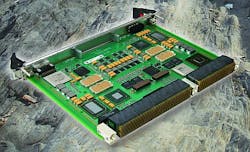4th Gen Intel Core processor raises the bar for high-performance embedded parallel processing
SANTA CLARA, Calif., 5 June 2013. Intel Corp. in Santa Clara, Calif., introduced the next generation of the company's Core i7 microprocessor on Tuesday, which triggered a flurry of product introductions by embedded computing manufacturers.
Announcing new high-performance embedded parallel processing (HPEPP) products based on the new Intel processor Tuesday were Extreme Engineering Solutions Inc. (X-ES) in Middleton, Wis.; Curtiss-Wright Controls Defense Solutions in Ashburn, Va.; Mercury Systems in Chelmsford, Mass.; GE Intelligent Platforms in Huntsville, Ala.; Kontron America Inc. in Poway, Calif.; LynuxWorks Inc. in San Jose, Calif.; and others.
Intel on Tuesday introduced the 4th generation Intel Core processor family, with enhanced graphics and as much as 15 percent better performance than the previous generation, company officials say.
Intel reduced power consumption at the CPU level to as low as six Watts, and used 22-nanometer process technology for the new chip. The CPU consumes a fraction of the power compared to previous idle states, graphics performance is about two times faster, and systems can wake up about eight times faster, Intel officials say.
The 4th generation Intel Core processor "is one of the most significant announcements that Intel has had for a couple of generations of the Intel Core i7," says Eran Strod, systems architect at embedded computing specialist Curtiss-Wright Controls Defense Solutions.
The 4th generation Intel Core processor for embedded computing "will decrease SWAP [size, weight, and power] by two to four times," Strod explains. "Designers now can do things that used to take two to four boards, and do it in one board," he says.
The new Intel microprocessor will be of special interest to designers of computationally intensive applications like sensor processing, electronic warfare, and signals intelligence because of the chip's enhanced ability to perform massively parallel embedded computing with its on-chip general-purpose graphics processing engine (GPGPU), Strod explains.
The 4th generation Intel Core processor's onboard GPGPU also can be programmed in the OpenCL language to make the chip's parallel processing functionality more accessible than ever before.
The AVX Intel instruction set that handles single instruction, multiple data (SIMD) parallel processing functions has been upgraded to AVX 2, which fuses multiply and add functions. This will enable embedded systems tasks that before took two clock cycles to complete in one clock cycle. "This feeds the processing engine much better than ever before," Strod says.
"Here we have this new capability to use the on-chip GPGPU with OpenCL software, and hundreds of gigaflops in performance by adding only a few Watts," Strod says. "Those kinds of innovations just don't come along every day."
Among the embedded computing products introduced Tuesday that are based on the 4th Generation Intel Core i7 are an OpenVPX (VITA 65) digital signal processing engine and a rugged, high performance VME single board computer from Curtiss-Wright; a rugged 3U VPX single board computer from GE Intelligent Platforms; a the COM Express basic computer-on-module from Kontron; VPX, VME, CompactPCI, XMC, and COM Express single-board computers from X-ES; a next generation high density server module from Mercury Systems; and software support for the new processor from LynuxWorks.
More new products based on the 4th generation Intel Core processor are expected today and in the coming weeks.
